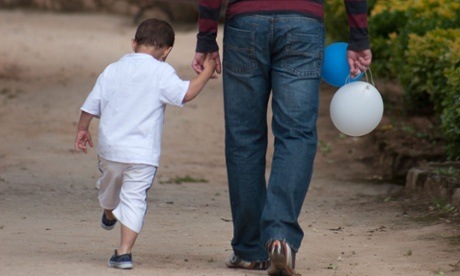
Fewer children were adopted in Australia in 2013-14 than in any previous recorded year, research from the Australian Institute of Health and Welfare has shown.
There were 317 finalised adoptions last year, a fall of 9% on the previous year. The AIHW said this was the smallest number of children adopted since national records began in 1968.
It also emerged the proportion of children legally adopted by their carers was the highest in a decade.
While the number of most types of adoption declined last year, there were 89 carer adoptions – in which children are placed with people such as foster parents – which is three times the number of 10 years ago. Proportionally, carer adoptions accounted for 5% of all adoptions in 2004-05, but last year accounted for 28%.
The institute said the rise was driven by legal changes in New South Wales which have increased the focus on adoptions by “known carers”.
A spokesman for the AIHW, Tim Beard, told Guardian Australia there was a “good chance” the numbers would increase further, because the data covered finalised adoptions and the reforms have been in place for only about 18 months.
“NSW has kind of taken the lead on this but other states and territories are certainly considering that as an option, as a path to go down as well, so we may see a flow-through,” Beard said.
The report showed that almost all local adoptions were by registered married couples, although only the Northern Territory has that as a legal requirement.
Just 1% of adoptive mothers in 2013-14 were under 30. Ages among birth mothers who placed their child for local adoption in Australia ranged from 15 to 44, and the median age, 24, was almost seven years younger than the average birth age for all women in 2012.
Almost four in five mothers who adopted a child from another country were over 40.
The number of finalised inter-country adoptions dropped from 129 in 2012-13 to 114 in 2013-14. The most common countries of origin were Taiwan, the Philippines and South Korea.
The prime minister last year pledged to make it easier for people to adopt children from overseas. Should he be successful, Beard predicted the number of inter-county adoptions would increase, but not in the short term because the process took several years.
Processing times are between a median of three years in Taiwan to almost eight years in China.
Regarding Tony Abbott’s pledge, Beard said: “It all depends on the detail behind that policy change and whether the streamlining can be put on the ground effectively.”
Among Aboriginal and Torres Strait Islander children, none of the seven adoptions in the past year fulfilled the governing principle of giving preference to extended family first, followed by the child’s Indigenous community, then other Indigenous Australians when approving adoptions.
“Where these options are not available or appropriate, Indigenous children may be adopted by other families,” the report said.
Few Indigenous children are adopted, making it difficult to determine a trend, the AIHW said, but of the 49 adoptions since 2003, 24 children were placed with non-Indigenous families.
Beard said the low numbers were due to the rarity of an Indigenous child being formally and legally adopted as opposed to placed in an out-of-home care arrangement.
“A lot of that is because the Indigenous placement principle … in every jurisdiction of Australia basically mandates states and territories to look very carefully and to place a child within the child’s family or kin, or another Indigenous family as a first priority,” he said.
“The picture that reads to me is that Indigenous young people are being placed into relative kinship care arrangements or foster care arrangements within Indigenous communities rather than taking the quite dramatic legal step of being adopted by another family.”
A report from the AIHW in July revealed Indigenous children were more than 10 times more likely to be taken from parents and placed in care than non-Indigenous children. The rate is higher in every jurisdiction in the country.
Of those taken from their parents, 68% of children were placed with relatives or kin, other Indigenous caregivers or in Indigenous residential care, in line with the principle.
However a recent NSW program trialling alternatives to removal was criticised by the Grandmothers Against Removals group as “paternalistic”.
